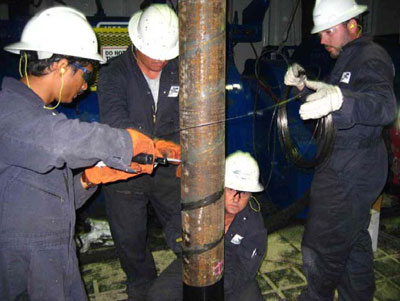Baker Hughes, Shell unveil Real-Time Compaction Imaging system
 A Real-Time Compaction Imaging (RTCI) system has been unveiled that can lead to significant savings in well completions by using fiber optics to monitor sand screen deformations and casing shape in real time. The system, jointly developed by Shell and Baker Hughes Incorporated, was previewed for the press on 9 July at the Baker Hughes Center for Technology Innovation in Houston. The RTCI system uses Bragg grating sensors incorporated within a sand screen instrumented with optical fibers to monitor strain and acquire a three-dimensional high-resolution deformation image of the screen. Tens of thousands of the sensors are spaced helically as close as 1 cm apart, each capable of measuring sub-micrometer deformations. They provide continuous and real-time monitoring of well deformation, reservoir compaction and well integrity, all without intervention. They are also sensitive to all tubular strains, including axial, bending, crushing, pressure and temperature.
A Real-Time Compaction Imaging (RTCI) system has been unveiled that can lead to significant savings in well completions by using fiber optics to monitor sand screen deformations and casing shape in real time. The system, jointly developed by Shell and Baker Hughes Incorporated, was previewed for the press on 9 July at the Baker Hughes Center for Technology Innovation in Houston. The RTCI system uses Bragg grating sensors incorporated within a sand screen instrumented with optical fibers to monitor strain and acquire a three-dimensional high-resolution deformation image of the screen. Tens of thousands of the sensors are spaced helically as close as 1 cm apart, each capable of measuring sub-micrometer deformations. They provide continuous and real-time monitoring of well deformation, reservoir compaction and well integrity, all without intervention. They are also sensitive to all tubular strains, including axial, bending, crushing, pressure and temperature.

The RTCI was successfully deployed at Pinedale, Wyo., on casing in 2008.
Vianney Koelman, Shell manager of in-well monitoring technology, noted that the operator decided to invest in this technology because there are many potential applications related to well integrity, production optimization and recovery optimization. One of the most important was measuring compaction and geomechnically induced well deformations, he said, which will provide early warnings for well failures – “an important reason we started all this back in 2002.”
“This is not a technology that is just an improvement over an existing technology. This is providing completely new measurements (that we weren’t capable of measuring before)… it will open up a whole new playground that will lead to further understanding what is going on downhole.”

Current deployment options for the RTCI are casing and 9 5/8-in. gravel pack systems. The first successful trial of the RTCI on casing took place at Shell’s Pinedale, Wyo., operations in 2008. The system was applied on two joints of 7-in. casing at different wrap angles – the wrap angle dictates sensitivity to a particular deformation mode. Key events during casing cementing (pumping cement, bumping the plug and cure) were clearly visible in the data.
A successful test of a sand control completion integrated with the fiber-optic RTCI system was completed in January 2009 at the Baker Hughes BETA test rig in Oklahoma. During the test, the wet connect successfully mated eight fibers with excellent optical connectivity (approximately 0.5 dB loss).
Additional field testing is planned for Q4 this year, when the system is expected to become available on the market.
To see a video of the RTCI horizontal gravel pack strain test, conducted in May 2009, click below.




